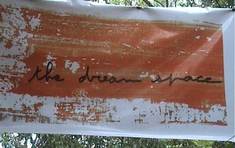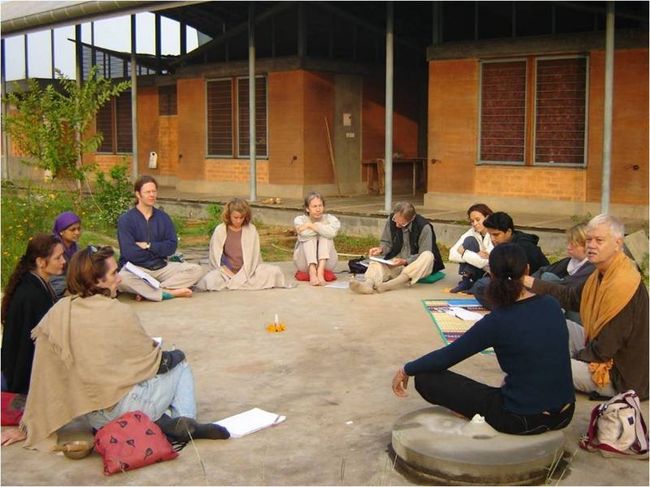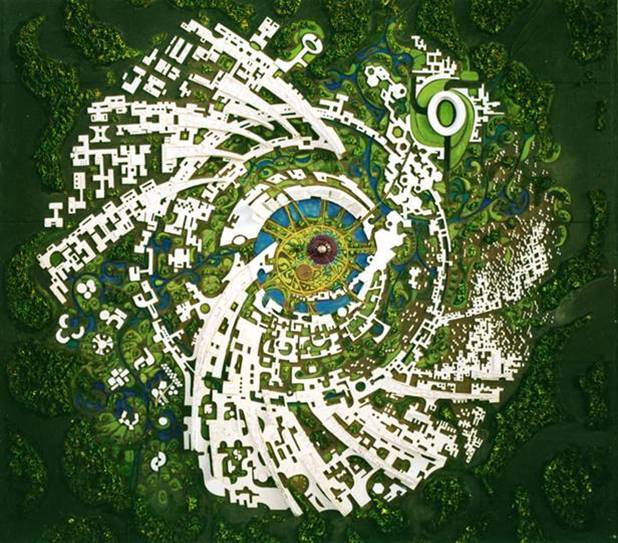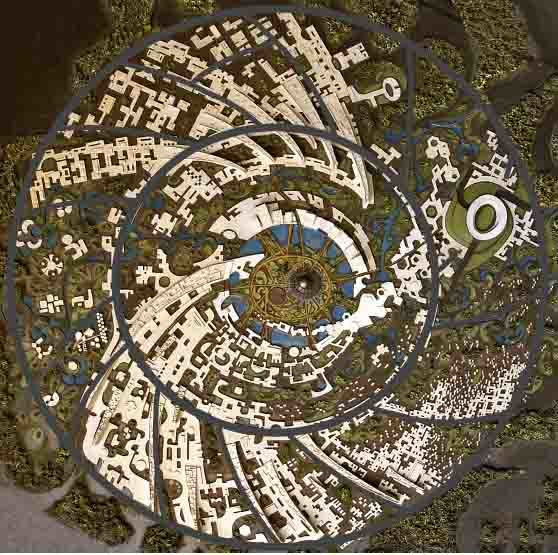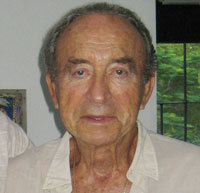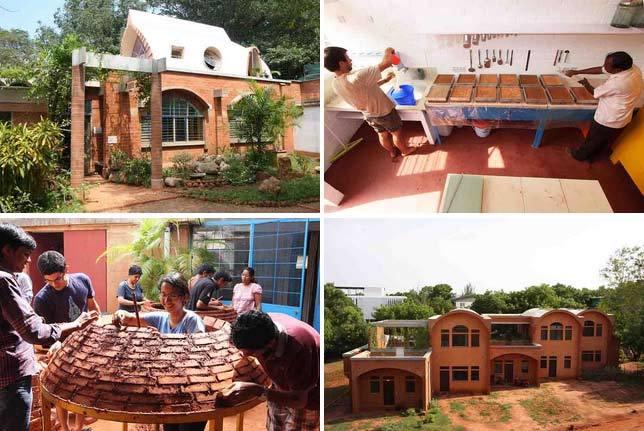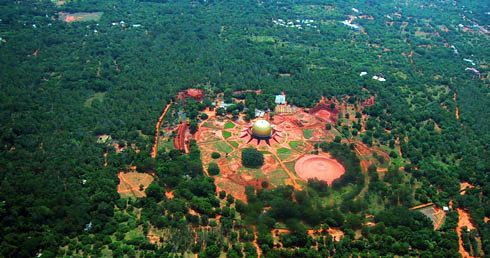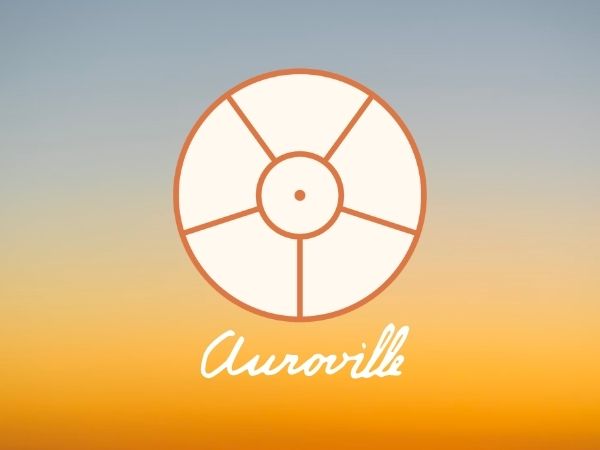Last updated:
The Galaxy: A pedestrian-based city (1968, 2003-5, 2015)
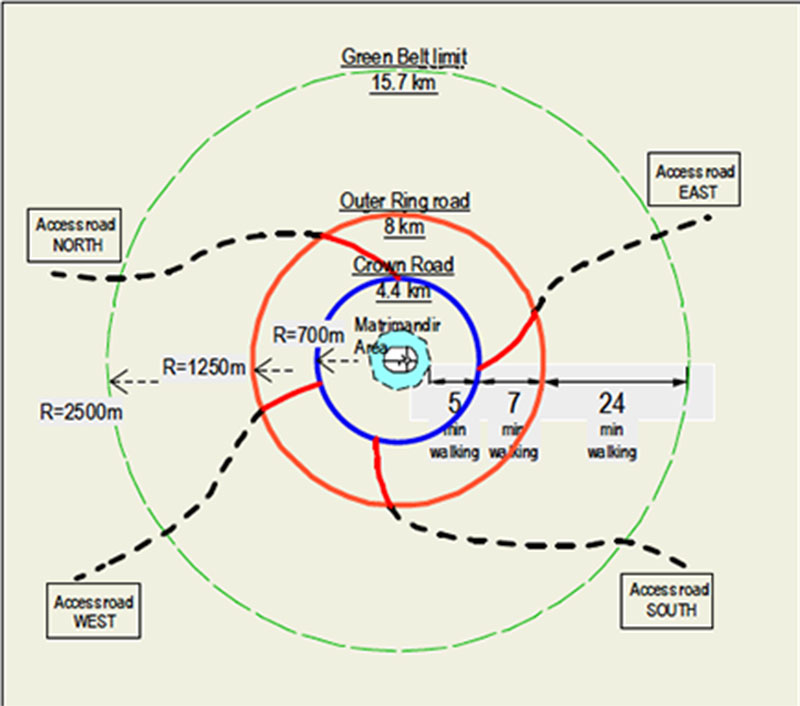
Freedom from motorised traffic
Car-free cities will probably become the norm by the second half of the 21st century due to energy constraints and increasing environmental consciousness. It seems appropriate, therefore, that Auroville should be willing to take a lead in its search for a new urban mobility that is ecologically sound.
The last 50 years have shown that the car cannot remain the instrument of urban mobility without adversely affecting the city. Cars and other motorised vehicles are the cause of serious environmental, social, and aesthetic problems. Among other things, they kill street life, foster urban sprawl, contribute to noise and air pollution, and are inefficient users of scarce energy resources.
Better alternatives are available. Most European cities now have car-free areas in their central zones, and everywhere these are in the process of being expanded.
The Mother’s Vision,1965
The original plan for Mother’s dream city did not include petrol-run cars. According to her vision, within the inner and outer ring road area, transport of people and goods would be by pedal-power (there would be a network of pleasant cycle and walking paths) and electric-powered vehicles: they would not overpower the streetscape because they are quiet and slow.
In September 1965, Mother noted that electrically-powered vehicles with a speed not exceeding 15 km/hour would be used for transport in the city.
Doctors, ambulances, and other emergency transport could enter, of course, with any type of vehicle.
Car-free Galaxy Plan, 2001/2005
In 2001 Mr. Hans Billinger, a traffic planner who lives in Stuttgart, Germany, told some Aurovilians that he considers the structure and proportions of the Galaxy plan ideal for a car-free culture: all areas of the city are within 5 or 6 minutes walking distance from the Crown Road. The outer ring road could take motorised traffic and connect with centralised parking areas there. Onward travel would be by bicycle or public transport via the radials and along the Crown, which could become the backbone of a public transport system (buses, tramways, or monorail).
The Crown Road is 4 kilometres long. Assuming an average speed for the public transport of 16 km/hour (including stops), the Crown Road can be circled within 15 minutes. If only one bus would be circling constantly, and one walks to and from the bus, it would still be possible to reach any point in town in less than 30 minutes.
In February 2005, Helmut Schmidt in consultation with Mr. Billinger, produced a basic concept document on Mobility for Auroville. Building on their studies this document re-interprets the information in order to create a set of design guidelines, as indicated and endorsed by the chief architect, Mr. Roger Anger. Final implementation will be based on further detailed technical studies, such as road levels, plinth levels, and other considerations.
Based on this network of roads and pathways there will be provided municipal shuttle services that will be accessible within reasonable walking distances from any point in the town. This collective transportation service will also connect to the service nodes on the outer edge of Auroville’s Green Belt.
Traffic system
The Auroville Master Plan envisages the street as a common space for all. Wherever vehicular movement is permissible within Auroville itself it will be restricted to approximately 15 km/h, a speed indicated by the Mother.
- All fast-moving vehicular traffic will remain outside the city limits. Parking areas would be provided on the periphery from where non-polluting transport alternatives would be provided for entry into the city areas.
- All of Auroville’s traffic systems will be provided and managed by the municipality.
- Auroville will provide the most energy-efficient, non-polluting, user-friendly modes of mass, and individual, public conveyance systems.
- There will be no other private or independent traffic systems inside the town (except for emergency access such as the ambulance).
City Area Mobility Guidelines by the Auroville Task Force, 2015
A group of Aurovilians (including Peter CS from Visitors Centre) who were part of the wider Mobility Task Force created the following draft which outlined further improvements on Auroville’s urban mobility. A location for the multi-storey car parking in the service area was included in this proposal.
The following recommendations were approved for Aurovilians and registered guests inside the city area:
1. Cycle rental
Cycles are available for daily/weekly rental at the Visitors Centre.
A buy-back scheme is in place for those who want to have a cycle for more than a month - they can buy a new cycle from Aurovelo, who will buy it back from them when they leave.
Next steps: expand the rental fleet by purchasing more cycles and basing them at Guest Houses, ensuring each Guest House has enough cycles easily available for their guests.
2. Electric two-wheeler rental
Start a rental fleet of electric mopeds, based at guest houses.
Discontinue the illegally-operated TVS moped rentals because they are neither registered nor insured for commercial rental purposes. Electric mopeds do not require registration or insurance.
3. Shuttle Transport within the city area.
City Transport was started to help guests reach their guest houses from the Visitors Centre and to provide an accessible transport option for those Aurovilians who do not want to use a two-wheeler or depend on a taxi.
It has succeeded in filling a niche part of the overall transport requirement - there are a number of Aurovilians (typically single, a certain age, female) who use it regularly.
It has also helped reduce auto-rickshaw traffic in the city area.
It was envisaged as a pilot or precursor of a fleet of free electric hop on/hop off shuttle vehicles plying regularly and frequently over city area routes and on-call so that Aurovilians' need for individual independent transport would be reduced.
4. Construction of a car parking garage in the Service Area
Resident car owners do not have to bring their cars all the way into the city area to reach their homes (this would reduce the need for parking spaces in the residential zone too). This would need to be combined with a dedicated shuttle vehicle to bring passengers to and from the garage.
It would also be combined with an Auroville taxi stand so that the taxis do not need to come for pick up and drop-offs within the city area - people would reach to and from the taxi stand by the shuttle vehicle.
Mobility for day visitors inside Auroville City Area
1. Solar electric tram project
Facilitate whatever is needed (project funds, skilled engineering staff/volunteers) to materialise the pilot project for running a solar electric tram. This is planned as a shuttle for visitors between the Visitors Centre and Matrimandir (to replace the vehicles which presently take the elderly/handicapped). Once it is up, running, and tested, it can be expanded further, to Solar Kitchen, Crown Road …. etc)
2. Cash sales prohibited within the City Area
Cafes/eateries inside the city area are meant for the use of Aurovilians and guests staying with guest card/Aurocard.
The Visitors Centre is the designated place for visitors to be able to purchase Auroville handicrafts and produce, and for day visitors to find something to eat.
Remind and insist on all units with premises in the City Area that there are not meant to be any cash transactions within the city area.
This applies to both cafes/eateries and units selling products.
Discourage guided tours within the city area as they also contribute to increased traffic of day visitors. If we follow this guideline it would considerably reduce the traffic generated by day visitors on two-wheelers or in cars going directly to showrooms or cafes within the city area.
3. Checkpost Procedures
Review and strengthen the checkpoint procedures for allowing day visitors vehicles into the City Area. At present Aurovilians insist on the checkpoint being opened if they are accompanying visitors: this is to be discontinued – surely it is up to Aurovilians to set a good example and follow the agreed format for day visitor groups.
4. Inside Auroville City Area mobility for goods traffic
Open the long envisaged link between the Industrial Zone and the Kottakarai-Alankuppam tar road to enable goods/courier traffic to reach the industrial zone without having to come up through the Visitors Centre checkpoint and past the Matrimandir/Town Hall.
The presently feasible route is through Windarra Farm to Kottakarai Plaza, north along the new section of the ring road, east up the Verite radial to EcoService, then turn left to join the CSR-Auroshilpam road.
Auroville’s special atmosphere
A pedestrian-based city would have a special atmosphere. The architecture would be different from that of auto-centered cities, providing a 'closeness' found in towns before the advent of the automobile. There will be visually-interesting passageways, as well as urban spaces encouraging collective meaningful interactions.
This ideal plan cannot, of course, be established immediately. Major construction activities in the city will continue for a long time to come and, as yet, Auroville lacks the means to substitute non-polluting transport for the diesel-fuelled brick delivery lorries and various vans that deliver goods. Having construction materials in special storage warehouses on the periphery of the city would create a more centralised and disciplined distribution system leading to a more peaceful environment overall.
If we agree upon the aim of creating a pedestrian-based city, then we can continue implementing the necessary steps outlined above.
(Based on input by Paulette and Helmut)
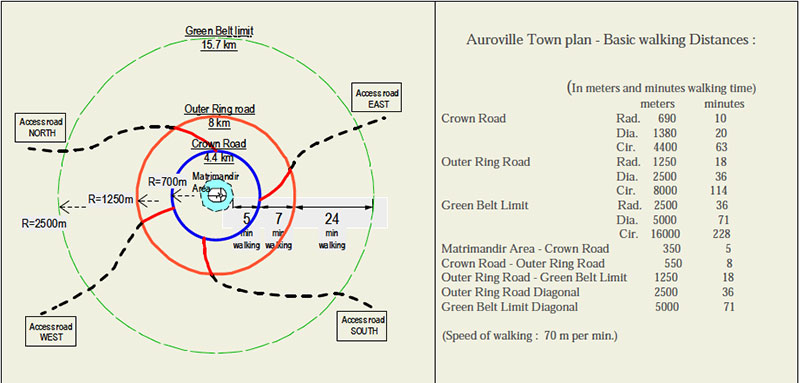
NOTE. The mobility plan by architect Helmut and Billinger traffic planner, approved by Roger Anger and Aurofuture (now TDC) in 2005, is attached - split into two because the file is too heavy.
Read also: https://auroville.org/contents/5152
"Raising the bar on mobility and urban planning"
